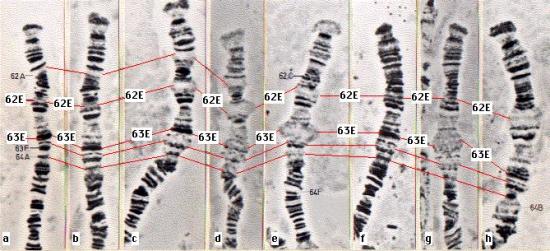D. melanogaster, D. melanogaster, Wherefore Art Thou, D. melanogaster?
Back when I was in AP Biology, we had a lab experiment that involved breeding Drosophila melanogaster for traits. After explaining the months-long fruit fly plague that had swept his classroom the last time he had tried doing the lab with real D. melanogaster, our teacher showed us the web-based simulation that we would be using this year.
So, I’ve never actually spent much time around fruit flies that didn’t involve swatting them. But that doesn’t mean I don’t know how important they are to geneticists! D. melanogaster are well suited to the study of hereditary traits for a great number of reasons, including their fecundity (18 points in Scrabble), short life cycle, and easily determined gender, not to mention that they are extremely easy and cheap to care for. They also have only four chromosomes (pictured above, because I wanted to find a relevant picture that didn’t give me the willies).
Drosophila researchers are in an uproar, however, over a taxonomic change that may rename the species.
The genus of drosophila is quite large, according to Nature.com, to the extent that “genetic data suggest[s] that some of its member species are more closely related to flies outside the genus than they are to other Drosophila species.”
Since a renaming seemed imminent, a proposal was made to the International Commission on Zoological Nomenclature that would have kept the name D. melanogaster, while allowing for a restructuring of the genus anyway. The proposal was rejected two weeks ago, opening the floor for a complete overhaul of how we refer to this famous fly.
In their written opinions, commission members gave several reasons for voting against the new proposal. Many called it premature because the science about the organization of the Drosophila genus remains unsettled. Others sought to limit the naming disruptions that would occur if the genus were split. Drosophila melanogaster fits within a subgenus called Sophophora, which includes some 350 members. Splitting this group off to form a new genus would require fewer renamings than would be needed if D. melanogaster became the type species for Drosophila. In that case, roughly 1,100 species would be pushed off into new genera.
Renaming, rewriting and reorganizing textbooks and papers is a considerable consequence of the restructuring of the Drosophila genus, but doesn’t a fly by a more specific and useful name still smell as sweet? Or something?
(via /.)
Have a tip we should know? [email protected]
